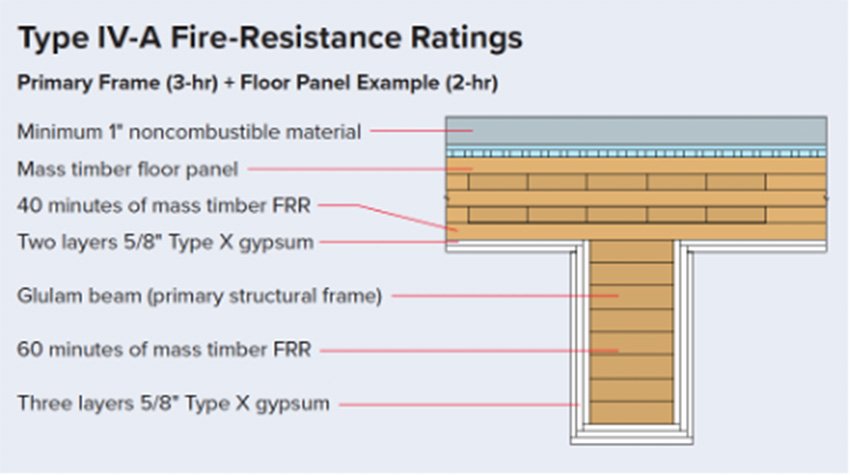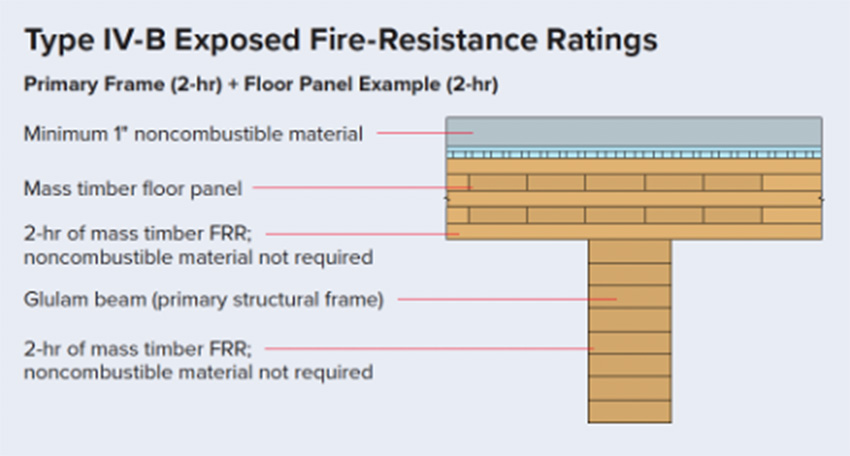2021 IBC: Building Bigger and Taller with Low-Carbon Wood
Learning Objectives:
- Explore the evolution of building with wood and the impact new IBC changes are having on the ability to specify mass timber in tall buildings that meet safety requirements for occupancy.
- Examine the new 2021 International Building Code changes related to tall wood construction, including three new building types that allow for wood buildings up to 18 stories and even taller using an Alternate Materials and Methods Requests (AMMR).
- Analyze design tactics and relevant code applications used to boost the density of light-frame wood construction and the impact these tactics have on the safety of the occupants within the built environment.
- Review the science related to wood’s embodied carbon and life-cycle assessment in the context of curbing a building’s impact on climate change.
Credits:
This course is approved as a Structured Course
This course can be self-reported to the AANB, as per their CE Guidelines
Approved for structured learning
Approved for Core Learning
This course can be self-reported to the NLAA
Course may qualify for Learning Hours with NWTAA
Course eligible for OAA Learning Hours
This course is approved as a core course
This course can be self-reported for Learning Units to the Architectural Institute of British Columbia
THE EVOLUTION OF BUILDING BIGGER AND TALLER WITH WOOD CONSTRUCTION
The built environment in the U.S. is growing at a rapid rate as a result of an ever-rising need for housing and infrastructure. It’s estimated that America is short more than 5 million homes1, and a boost in infrastructure spending is further accelerating new construction2. At the same time, buildings and their construction account for more than a third of global carbon dioxide emissions3, with 11% of carbon emissions generated from the building materials and construction4. This embodied carbon can account for half of the total carbon footprint over the lifetime of a building5.
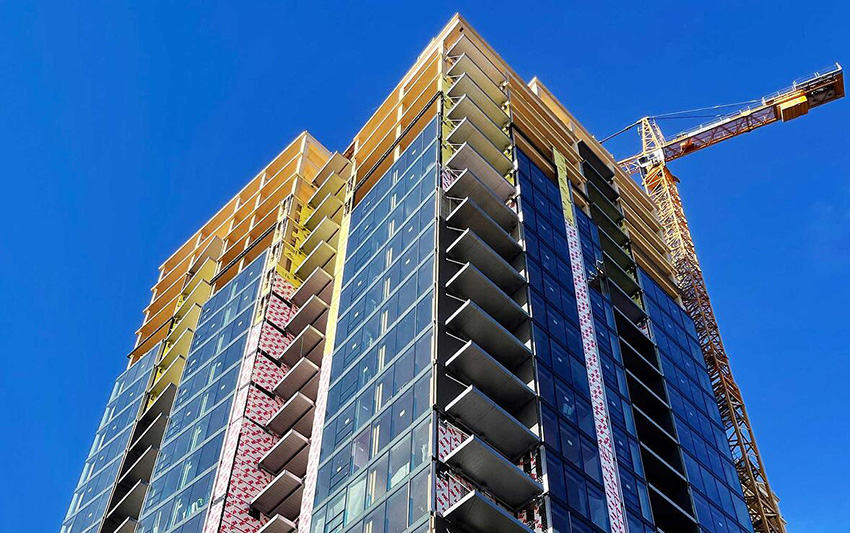
Photo: CD Smith
Ascent in Milwaukee, completed July 2022, is 25 stories tall and constructed from CLT floor panels supported on glulam beams and columns with two reinforced concrete cores by architect Thornton Tomasetti.
To address these concerns, some policymakers6 and design teams7 are turning, in part, to timber—a naturally renewable building material that, being 50% carbon by dry weight8, can lock in carbon over the lifetime of a building9. Product advancements, new capabilities of hybrid-timber construction, fire testing, and fire-resistant designs have all contributed to an increased capacity to build larger and taller buildings using low-carbon wood products.
In this course, you’ll learn about the 2021 International Building Code (IBC) changes related to tall wood construction, including three new building types that allow for wood buildings up to 18 stories10 and even taller using an Alternate Materials and Methods Requests (AMMR)11. Rigorous fire testing was conducted as part of these code changes to validate the safety of tall mass timber construction.
Along with advancements in tall mass timber construction, the course explores design tactics and relevant code applications used to boost the density of light-frame wood construction. Finally, this course will review the science related to wood’s embodied carbon and life-cycle assessment in the context of curbing a building’s impact on climate change, including a growing body of research demonstrating how building with timber represents an opportunity to increase the long-term storage of carbon in today’s built environment12.
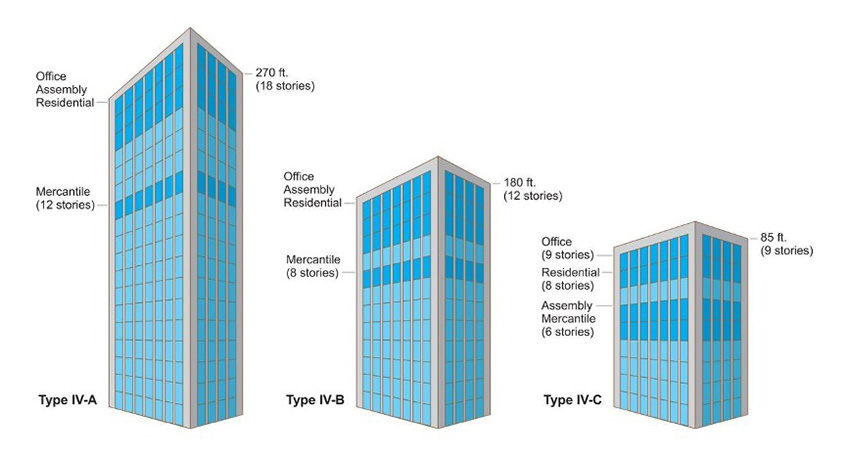
Photo courtesy of WoodWorks
Representative Building Sizes for Business Occupancy.
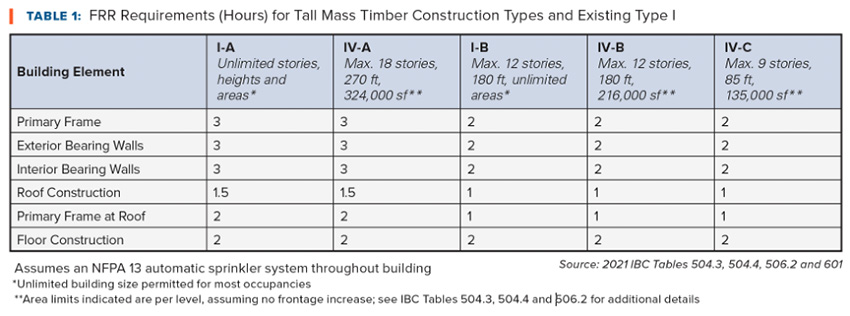
GLOBAL TREND TOWARDS TALL MASS TIMBER BUILDINGS
Over the past 15 years, there has been a growing interest in tall buildings constructed from mass timber materials. This has been coupled with technical advancements that one architect described as “a timber renaissance, with new milestones in timber construction being reached at a breakneck pace13.” Around the world, there are now dozens of timber buildings constructed above eight stories tall. International examples include Brock Commons in Vancouver, BC (18 stories), Mjøstårnet in Norway (18 stories), and HoHo Wien in Austria (24 stories).
In the United States, such buildings have been constrained by a strong reliance on prescriptive building code limits and less willingness to use performance-based fire protection engineering. That said, mass timber construction has grown significantly, and changes to the 2021 IBC have greatly increased the pace at which new tall mass timber projects are being proposed. As of early 2022, more than 1,300 mass timber projects have been built, are under construction, or in design in the US14; more than 160 of these are considered tall mass timber projects, exceeding the height and/or story limits for mass timber under the 2018 IBC.
THE PATH TO 2021 CODE CHANGES: ICC TALL WOOD BUILDING AD HOC COMMITTEE
In response to the growing interest in tall wood buildings, particularly those constructed from new mass timber materials, the International Code Council (ICC) chartered the Ad Hoc Committee on Tall Wood Buildings (TWB) in December 2015. The purpose of this committee was to “explore the building science of tall wood buildings and investigate the feasibility of and take action on developing code changes for tall wood buildings.” Initial activities included reviewing the technical state of mass timber knowledge and building performance and developing a series of compartment fire tests to test the proposed construction types.
In January 2018, the Committee submitted a set of 14 IBC code change proposals to the ICC 2018 Group A code development process, targeting changes to the 2021 IBC. In January 2019, 3 additional code change proposals were submitted by the TWB as part of the Group B cycle. All 17 code change approvals were approved for inclusion in the 2021 IBC, some as submitted and some with modifications.
Concurrently with the development of the IBC code change proposals, the committee overseeing the code-referenced CLT product standard, ANSI/APA PRG-320 Standard for Performance-Rated Cross-Laminated Timber (PRG-320), responded to the desire by fire service representatives on the TWB for higher assurances of CLT behavior in high-rise construction by incorporating a new required test for adhesives used in CLT production. Passing this test is required for adhesives used in all CLT complying with the 2019 edition of PRG 320, referenced in IBC 2021. This test is based on a 4-hour compartment-like fire test designed “to identify and exclude use of adhesives that permit CLT char layer fall-off resulting in fire regrowth during the cooling phase of a fully developed fire.”
2021 IBC CODE CHANGES FOR WOOD CONSTRUCTION
New Tall Timber Construction Types
In looking at the existing tall wood buildings proposed and built around the country and world, the TWB decided to propose expanding the existing Type IV construction by adding three new sub-types—IV-A, IV-B, and IV-C—and renaming Type IV as Type IV-HT. Similar to the noncombustible construction types I and II, the four “mass timber” construction types are arranged from the highest fire resistance and safety requirements (IV-A) to the lowest (IV-HT).
These three new construction types introduced in the 2021 IBC each have different maximum allowable heights, stories, and areas. Type IV-A allows the greatest height and area and has the most stringent fire protection requirements (e.g., fire-resistance ratings, noncombustible protection, etc.), followed by Types IV-B and IV-C. Conceptually, Type IV-A is similar to the existing construction Type I-A (which requires a fully non-combustible structure), with equal or greater fire-resistance rating requirements and no exposed mass timber.
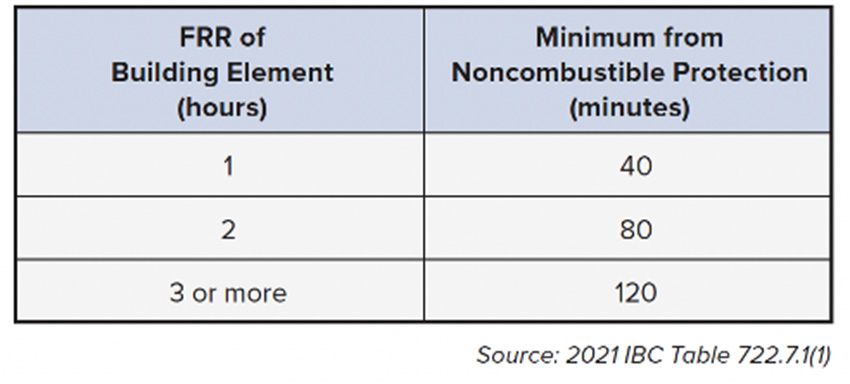
Type IV-C is similar to Type IV-HT with almost all of the interior mass timber permitted to be exposed; however, most structural building components have a 2-hour FRR in addition to minimum heavy timber sizes, resulting in an increase in the allowable number of stories when compared to IV-HT. The TWB also determined that an intermediate construction type between IV-A and IV-C was needed, resulting in Type IV-B. For multi-family occupancies, Type IV-A permits a timber structure of up to 18 stories and 270 feet, Type IV-B permits up to 12 stories and 180 feet, and Type IV-C permits up to 8 stories and 85 feet.
